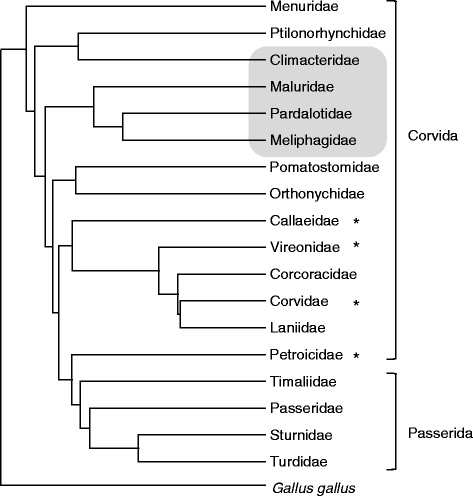New data from basal Australian songbird lineages show that complex structure of MHC class II β genes has early evolutionary origins within passerines
- PMID: 27206579
- PMCID: PMC4875725
- DOI: 10.1186/s12862-016-0681-5
New data from basal Australian songbird lineages show that complex structure of MHC class II β genes has early evolutionary origins within passerines
Abstract
Background: The major histocompatibility complex (MHC) plays a crucial role in the adaptive immune system and has been extensively studied across vertebrate taxa. Although the function of MHC genes appears to be conserved across taxa, there is great variation in the number and organisation of these genes. Among avian species, for instance, there are notable differences in MHC structure between passerine and non-passerine lineages: passerines typically have a high number of highly polymorphic MHC paralogs whereas non-passerines have fewer loci and lower levels of polymorphism. Although the occurrence of highly polymorphic MHC paralogs in passerines is well documented, their evolutionary origins are relatively unexplored. The majority of studies have focussed on the more derived passerine lineages and there is very little empirical information on the diversity of the MHC in basal passerine lineages. We undertook a study of MHC diversity and evolutionary relationships across seven species from four families (Climacteridae, Maluridae, Pardalotidae, Meliphagidae) that comprise a prominent component of the basal passerine lineages. We aimed to determine if highly polymorphic MHC paralogs have an early evolutionary origin within passerines or are a more derived feature of the infraorder Passerida.
Results: We identified 177 alleles of the MHC class II β exon 2 in seven basal passerine species, with variation in numbers of alleles across individuals and species. Overall, we found evidence of multiple gene loci, pseudoalleles, trans-species polymorphism and high allelic diversity in these basal lineages. Phylogenetic reconstruction of avian lineages based on MHC class II β exon 2 sequences strongly supported the monophyletic grouping of basal and derived passerine species.
Conclusions: Our study provides evidence of a large number of highly polymorphic MHC paralogs in seven basal passerine species, with strong similarities to the MHC described in more derived passerine lineages rather than the simpler MHC in non-passerine lineages. These findings indicate an early evolutionary origin of highly polymorphic MHC paralogs in passerines and shed light on the evolutionary forces shaping the avian MHC.
Keywords: Accordion model; Birth-and-death model; Concerted evolution; Convergent evolution; Corvida; Gene duplication; Passerida; Trans-species polymorphism.
Figures



Similar articles
-
MHC class II β exon 2 variation in pardalotes (Pardalotidae) is shaped by selection, recombination and gene conversion.Immunogenetics. 2017 Feb;69(2):101-111. doi: 10.1007/s00251-016-0953-7. Epub 2016 Oct 8. Immunogenetics. 2017. PMID: 27717988
-
Extensive MHC class II B gene duplication in a passerine, the common Yellowthroat (Geothlypis trichas).J Hered. 2010 Jul-Aug;101(4):448-60. doi: 10.1093/jhered/esq018. Epub 2010 Mar 3. J Hered. 2010. PMID: 20200139
-
Gene duplication and gene conversion in class II MHC genes of New Zealand robins (Petroicidae).Immunogenetics. 2004 Jun;56(3):178-91. doi: 10.1007/s00251-004-0666-1. Epub 2004 May 8. Immunogenetics. 2004. PMID: 15138734
-
Major Histocompatibility Complex (MHC) Genes and Disease Resistance in Fish.Cells. 2019 Apr 25;8(4):378. doi: 10.3390/cells8040378. Cells. 2019. PMID: 31027287 Free PMC article. Review.
-
Evolution of MHC IIB Diversity Across Cichlid Fish Radiations.Genome Biol Evol. 2023 Jun 1;15(6):evad110. doi: 10.1093/gbe/evad110. Genome Biol Evol. 2023. PMID: 37314153 Free PMC article. Review.
Cited by
-
Distinct evolutionary trajectories of MHC class I and class II genes in Old World finches and buntings.Heredity (Edinb). 2021 Jun;126(6):974-990. doi: 10.1038/s41437-021-00427-8. Epub 2021 Apr 6. Heredity (Edinb). 2021. PMID: 33824536 Free PMC article.
-
Avian MHC Evolution in the Era of Genomics: Phase 1.0.Cells. 2019 Sep 26;8(10):1152. doi: 10.3390/cells8101152. Cells. 2019. PMID: 31561531 Free PMC article. Review.
-
A quantitative and qualitative comparison of illumina MiSeq and 454 amplicon sequencing for genotyping the highly polymorphic major histocompatibility complex (MHC) in a non-model species.BMC Res Notes. 2017 Jul 28;10(1):346. doi: 10.1186/s13104-017-2654-1. BMC Res Notes. 2017. PMID: 28754172 Free PMC article.
-
Polymorphism in the major histocompatibility complex (MHC class II B) genes of the Rufous-backed Bunting (Emberiza jankowskii).PeerJ. 2017 Jan 25;5:e2917. doi: 10.7717/peerj.2917. eCollection 2017. PeerJ. 2017. PMID: 28149689 Free PMC article.
-
Early Duplication of a Single MHC IIB Locus Prior to the Passerine Radiations.PLoS One. 2016 Sep 22;11(9):e0163456. doi: 10.1371/journal.pone.0163456. eCollection 2016. PLoS One. 2016. PMID: 27658204 Free PMC article.
References
-
- Klein J. Natural history of the major histocompatibility complex. New York: Wiley; 1986.
-
- Klein J, Ono H, Klein D, O’hUigin C. The Accordion Model of Mhc Evolution. In: Gergely J, Benczúr M, Erdei A, Falus A, Füst G, Medgyesi G, editors. Prog. Immunol. Berlin Heidelberg: Springer; 1993. pp. 137–43.
MeSH terms
Substances
LinkOut - more resources
Full Text Sources
Other Literature Sources
Research Materials

